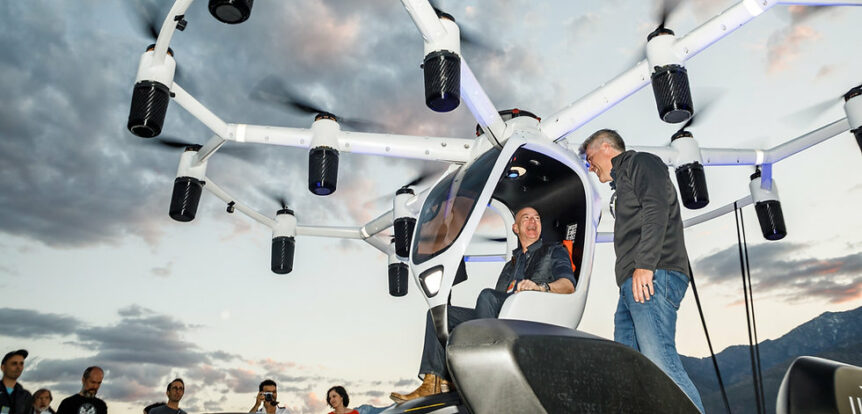…Or Invest In
We exhibit here three personal flyers you can buy today or within a year or so. Perhaps that wait might be prolonged in some instances because a few of the makers are also looking for investors. Recent instances of troubles getting a certain stainless steel electric pickup to market come to mind, for instance. As always your mileage may vary.
Doroni H1-X
“Engineered for the new generation of personal mobility,” the Doroni H1-X is a sleek little four-fan runabout that can fit in a two-car garage. Two pusher propellers help drive if forward. An owner could roll it out after an overnight charging session and fly up to 60 miles at up to 120 miles per hour, landing and taking off vertically from and to a driveway-size patch.
Obviously, with a $300,000 to $400,000 price tag, one expects a well-sorted-out machine that will perform as promised and provide the utmost in safety. To that end, Doroni suggests only minimal training will be required, possibly relying on near-autonomous controls. Certainly, Doroni lists “autonomous equilibrium” as a feature, with a central control stick and instrumentation for those who want to try out their manual flying skills from either side of the cockpit.
Anti-collision sensors will keep the H1-X from banging into other commuters or obstacles, and if all goes south, a ballistic parachute will lower the whole assemblage gently (one hopes) to terra firma.
Loz Blain in New Atlas.com, questions the ability of the airflow over the wings to make that all-important 90-degree turn into the fans, but Doroni answers that in its introductory video, calling on research into early jet aircraft design.
eHang EH-216H
Just a week ago, eHang staged a fairly impressive demonstration with 12 EH-216S models climbing into a wintry sky and coming back to earth safely.
Impressive as this is, the idea that literally thousands of people, including eHang’s entire board of directors, is even more so. There are no controls in the cabin other than a touch screen that allows users to identify their destination. The machine takes over from there.
At $410,000, the eHang sits in the middle of our price range, its fully-autonomous operation will be reassuring to newbies but will also require a considerable level of trust. Supposedly, the EH-216’s demonstrated abilities will vouch for its trustworthiness.
Hexa Lift
At the top of the price list, and the most personal of these three Personal Air Vehicles (PAVs), the Hexa Lift demonstrates its ability to haul a relatively untrained soul skyward in safety. The Air Force is testing them for possible military applications.
The $495,000 single seater seems the one most likely to cause the well-heeled to question its utility. Plugging in 16 batteries under each of its motors may test the patience of those who want to just hop in and go. It does increase the redundancy factor, though.
It’s also being promoted as an emergency response vehicle, which brings into question that potential use for many of these small craft. Gwen Lighter is currently hosting the GoAero Prize, aimed at exploiting small electric fire-fighting and rescue vehicles that can arrive quickly at a crisis scene and bring help to an otherwise chaotic situation.
Whether providing a convenient way around the morning traffic jam or helping save those in distress, we have not yet begun to look at useful applications for this maturing technology.

